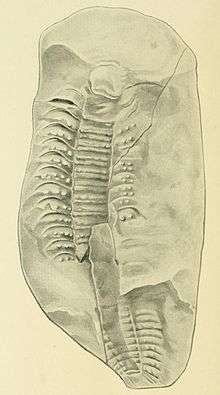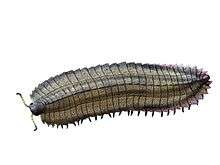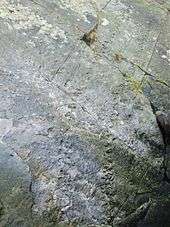Arthropleura
| Arthropleura Temporal range: Mississippian-Cisuralian, 340–280 Ma | |
|---|---|
 | |
| Fossil A. armata illustration | |
| Scientific classification | |
| Kingdom: | Animalia |
| Phylum: | Arthropoda |
| Subphylum: | Myriapoda |
| Class: | Diplopoda |
| Subclass: | † Arthropleuridea |
| Order: | † Arthropleurida Waterlot, 1934 |
| Family: | † Arthropleuridae Zittel, 1848 |
| Genus: | † Arthropleura Meyer, 1853 |
| Species | |
| |
Arthropleura (Greek for Jointed Ribs) is a genus of extinct, 0.3–2.3 metre (1–7.5 feet) long[1] millipede arthropods, native to the upper Carboniferous (323 to 299 million years ago) of what is now northeastern North America and Scotland. The larger species of the genus are the largest known land invertebrates of all time, and would have had few, if any, predators.
Description

Arthropleura was able to grow larger than modern arthropods, partly because of the greater partial pressure of oxygen in Earth's atmosphere at that time, and because of the lack of large terrestrial vertebrate predators.[2] Arthropleura became extinct at the end of the Carboniferous period, when the moist climate began drying out, reducing the rainforests of the Carboniferous, and allowing the desertification characteristic of the Permian.[3]
Paleobiology

Contrary to earlier and popular beliefs, Arthropleura was not a predator but a herbivorous arthropod. Because none of the known fossils have the mouth preserved, scientists suppose that Arthropleura did not have strongly sclerotized and powerful mouth parts, because such would have been preserved at least in some of the fossils. Some fossils have been found with lycopod fragments and pteridophyte spores in the gut and in associated coprolites.[4]
Fossilized footprints from Arthropleura have been found in many places. These appear as long, parallel rows of small prints, which show that it moved quickly across the forest floor, swerving to avoid obstacles, such as trees and rocks. Its tracks have the ichnotaxon name Diplichnites cuithensis.[5][6]
References
- ↑ Braddy et al. (2008)
- ↑ M. G. Lockley & Christian Meyer (2013). "The tradition of tracking dinosaurs in Europe". Dinosaur Tracks and Other Fossil Footprints of Europe. Columbia University Press. pp. 25–52. ISBN 9780231504607.
- ↑ Thom Holmes (2008). "The first land animals". March Onto Land: the Silurian Period to the Middle Triassic Epoch. The Prehistoric Earth. Infobase Publishing. pp. 57–84. ISBN 9780816059591.
- ↑ A. C. Scott; W. G. Chaloner & S. Paterson (1985). "Evidence of pteridophyte–arthropod interactions in the fossil record" (PDF). Proceedings of the Royal Society of Edinburgh. 86B: 133–140.
- ↑ Adrian P. Hunt; Spencer G. Lucas; Allan Lerner; Joseph T. Hannibal (2004). "The giant Arthropleura trackway Diplichnites cuithensis from the Cutler Group (Upper Pennsylvanian) of New Mexico". Geological Society of America Abstracts with Programs. 36 (5): 66.
- ↑ Briggs, D. E.; Plint, A. G. & Pickerill, R. K. (1984). "Arthropleura trails from the Westphalian of eastern Canada." (PDF). Palaeontology. 27 (4): 843–855.
External links
| Wikimedia Commons has media related to Arthropleura. |
- Lyall I. Anderson; Jason A. Dunlop; Carl A. Horrocks; Heather M. Winkelmann; R. M. C. Eagar (1998). "Exceptionally preserved fossils from Bickershaw, Lancashire UK (Upper Carboniferous, Westphalian A (Langsettian))". Geological Journal. 32 (3): 197–210. doi:10.1002/(sici)1099-1034(199709)32:3<197::aid-gj739>3.0.co;2-6.
- A profile of the Arthropleura